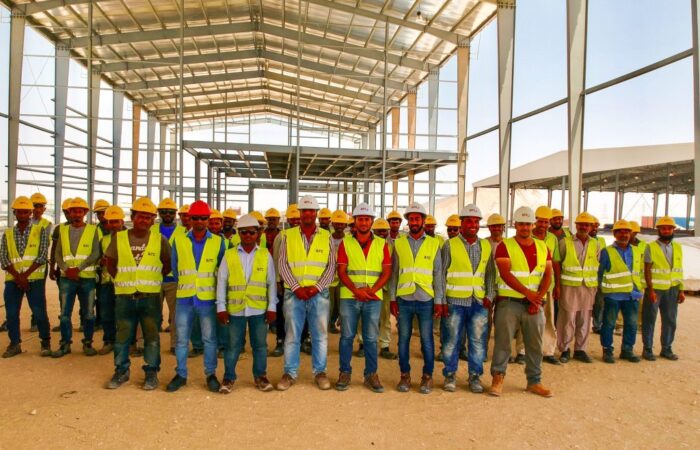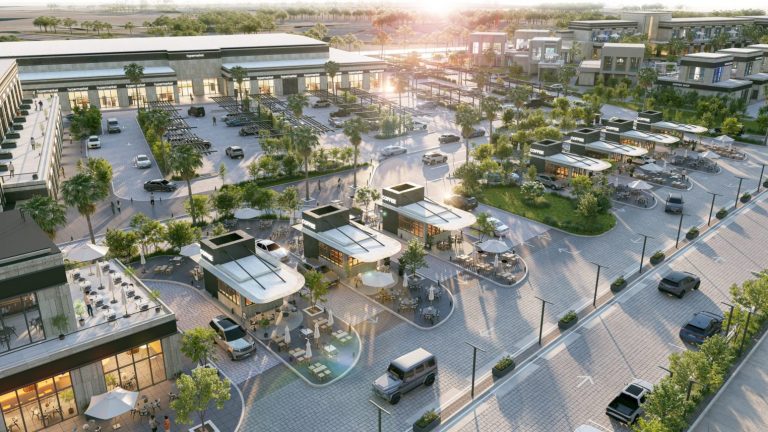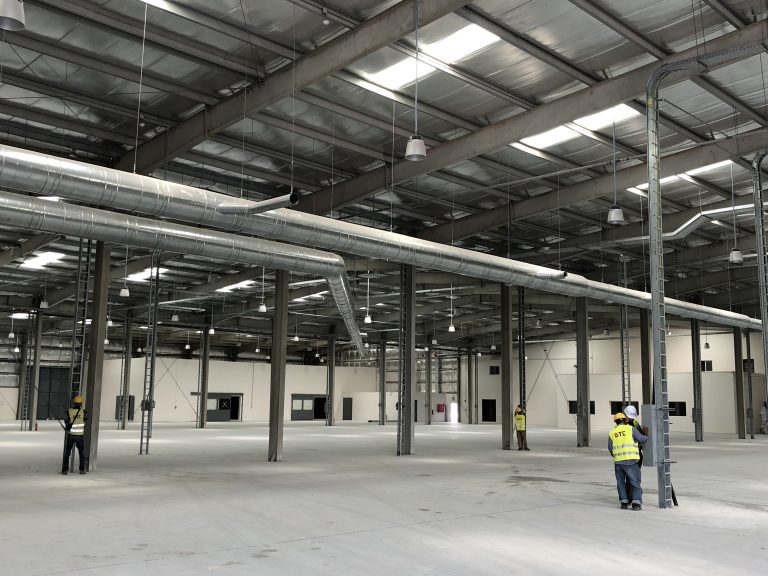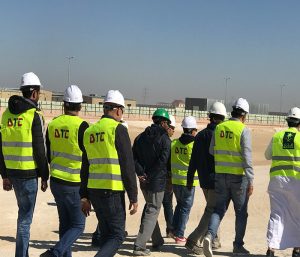Pre Engineered Buildings – Know More About PEBs Structure
A pre-engineered building (PEB) is a type of building structure that is designed and fabricated using prefabricated components. These components are manufactured in a factory and then transported to the site for assembling. PEBs are used in the construction of industrial, commercial and other types of buildings.
Pre Engineered Buildings
Pre-engineered buildings (PEBs) are steel structures fabricated using steel members that are manufactured and shipped from the factory to the site. The members are then assembled on site by trained personnel using high-strength bolts. This type of construction is also known as bolted steel construction.
PEBs are an efficient and cost-effective solution for a wide range of building types such as warehouses, factories, office buildings, shopping centres, stadiums, hangars and so on. PEBs offer many advantages over traditional methods of construction, such as shorter construction time, reduced labour costs, improved quality control and enhanced safety.
There are three main types of pre-engineered buildings: clear span buildings, single slope buildings and multi-span buildings. Clear span buildings have no interior supports and can span up to 300 feet without intermediate columns or beams. Single slope buildings have a sloped roof with one end higher than the other and are commonly used for car parks or storage facilities. Multi-span buildings have more than one roof plane and are typically used for larger warehouses or manufacturing plants.
When designing a pre-engineered building, the first step is to determine the loads that will be placed on the structure including dead loads (weight of the building components), live loads (weight of people and furniture) and wind loads (forces exerted by the wind). Once these loads are known, the next step is to design the framing system which includes the primary structural elements such as columns, beams and
What is the meaning of pre engineering building?
Pre-engineered buildings are factory-built structures that are assembled on site. These buildings are designed to meet specific structural and aesthetic requirements. PEBs are made from a variety of materials, including wood, steel, concrete, and glass. PEBs can be adapted to any climate and can be disassembled and relocated if necessary.
PRE ENGINEERED BUILDING (PEB) STRUCTURES
Pre Engineered Buildings (PEB) are the buildings which are constructed using pre-engineered steel building systems. These buildings are designed by pre-calculating the height, width, length, and other parameters of the building. This helps in reducing the construction time as well as the cost of construction.
There are many benefits of PEB structures over traditional building structures. Some of them are mentioned below:
1. PEB structures are much lighter in weight when compared to traditional buildings. This helps in saving a lot of money on the foundation and other supporting structures.
2. PEB structures can be easily disassembled and relocated to another site if required. This is not possible with traditional buildings.
3. The construction time of PEB structures is much less when compared to traditional buildings. This helps in saving a lot of time and money on the construction process.
4. PEB structures are much more resistant to earthquakes and high winds when compared to traditional buildings. This makes them ideal for areas which are prone to these natural disasters.
What are the advantages of pre-engineered buildings?
There are several advantages of pre-engineered buildings, which is one of the reasons why they are gaining popularity in various industries. Some of the advantages are mentioned below:
1.They offer a high degree of flexibility as they can be quickly erected and dismantled as per the requirement.
2.They are easy to transport from one place to another as they are light in weight and can be easily loaded and unloaded.
3.They can be constructed in any terrain or location, irrespective of the geographical conditions.
4.They offer superior resistance to natural calamities like earthquakes, hurricanes, etc., due to their robust construction.
5.They are extremely cost-effective as compared to traditional buildings
What are the advantages and disadvantages of pre-engineered buildings?
Pre-engineered buildings (PEBs) are fast gaining popularity in the construction industry owing to the many advantages they offer. However, like with everything else, there are also some disadvantages associated with PEBs. Below, we take a look at both the pros and cons of pre-engineered buildings:
Advantages of Pre Engineered Buildings
1. They are extremely versatile and can be used for a wide range of applications such as warehouses, manufacturing plants, office buildings, retail outlets, etc.
2. They are very easy and quick to construct as compared to conventional buildings. This helps in saving a lot of time and money.
3. PEBs offer a high degree of flexibility when it comes to design and can be easily customized as per the specific requirements of the client.
4. They are quite strong and durable thanks to the use of high-quality materials in their construction. This makes them ideal for usage in harsh weather conditions or areas prone to earthquakes or hurricanes.
5. Pre engineered buildings are quite energy efficient as well since they make use of thermal insulation which helps keep the interiors cool in summers and warm in winters – thereby reducing the overall energy consumption by a significant margin.
Disadvantages of Pre Engineered Buildings
1. The initial cost of constructing a pre engineered building is usually higher than that of a conventional building but this difference evens out over time because of the various cost-savings associated
Where are pre-engineered structures best used?
Pre-engineered structures are typically used in industrial and commercial applications where a large, open space is required. They are also often used in agricultural buildings, such as barns and storage sheds. Pre-engineered buildings are less expensive and easier to construct than traditional stick-built structures, and they can be adapted to a variety of uses.
PRE ENGINEERED BUILDING (PEB) application
Pre engineered buildings are gaining popularity in the construction industry because of their many advantages. PEBs are factory-built structures that are shipped to the site and assembled on a foundation. They are designed and manufactured using state-of-the-art technology that makes them stronger, faster to construct, and more cost-effective than traditional buildings.
There are many applications for pre engineered buildings, such as warehouses, office buildings, retail stores, manufacturing plants, and distribution centers. PEBs can be customized to meet the specific needs of each project. For example, they can be designed with large open spaces for manufacturing or with smaller offices and conference rooms for office buildings.
Pre engineered buildings are also becoming popular in the residential market. Many homeowners are choosing PEBs for their homes because they offer the same benefits as commercial PEBs – they are strong, fast to construct, and cost-effective. In addition, PEBs can be designed to meet the unique needs of each home, such as incorporating green features or providing more living space.
PRE ENGINEERED BUILDING – factory
A pre-engineered building (PEB) is a building that is built using prefabricated components. These components are manufactured in a factory and then assembled on site. PEBs are usually used for commercial and industrial buildings, such as warehouses, factories and office buildings.
PEBs are a type of steel construction that is becoming increasingly popular in many parts of the world, due to its many advantages over traditional construction methods. PEBs are less expensive, easier to erect and have a shorter construction time. In addition, PEBs are more environmentally friendly than traditional buildings, as they use less energy and generate less waste.
If you are considering constructing a commercial or industrial building, a pre-engineered building may be the right choice for you.
PRE ENGINEERED BUILDING – warehoouse
Pre Engineered Buildings are the structures which are constructed using pre-designed building components. These components are manufactured in a factory setting, using advanced machines and equipment. This results in a more efficient and cost-effective construction process, as compared to traditional methods.
PEBs are designed to meet the specific requirements of the customer, making them highly versatile. They can be used for a wide range of applications, such as warehouses, office buildings, retail stores, manufacturing plants, and more. PEBs are also easy to expand or modify, making them ideal for businesses that are growing rapidly.
There are many benefits to using Pre Engineered Buildings. Some of the most notable benefits include:
– Reduced construction time: PEBs are manufactured in a factory setting, which reduces the construction time on site. This can be particularly beneficial for large projects where time is of the essence.
– Reduced construction costs: The use of prefabricated components can save on both labor and materials costs. In addition, PEBs often require less maintenance than traditional structures.
– Greater design flexibility: PEBs can be designed to meet the specific requirements of the customer. This allows for greater creativity in the design process, as well as increased functionality.
– Enhanced sustainability: PEBs often have a smaller environmental impact than traditional buildings due to their use of prefabricated components and recycled materials. In addition, they can often be designed to incorporate energy-efficient features such as
PRE ENGINEERED BUILDING – workshop
Pre-engineered buildings are factory-built structures that are shipped to the job site and assembled using a crane. The main advantage of pre-engineered buildings is that they are quick and easy to construct, which saves time and money.
Pre-engineered buildings are also very strong and durable, due to the fact that they are made with high-quality materials. Pre-engineered buildings can be designed to meet any type of building code, making them very versatile.
If you are thinking about constructing a new building, consider using pre-engineered building technology. You’ll save time and money, and end up with a high-quality structure.
PRE ENGINEERED BUILDING – cold storage
Pre engineered buildings (PEBs) are the perfect solution for those looking for a cost-effective and fast-to-assemble storage option. PEBs are prefabricated buildings that are made up of light gauge metal alloys. They are designed and manufactured in a factory setting, which allows for greater control over the quality of the final product.
One of the most popular uses for PEBs is cold storage. These buildings can be used to store food, pharmaceuticals, or any other temperature-sensitive items. The metal alloy framing can be insulated to ensure that the interior temperature remains consistent. Cold storage PEBs are also typically outfitted with specialized doors and ventilation systems to further regulate the environment inside.
When it comes to choosing a pre engineered building for cold storage, it’s important to work with a reputable manufacturer. Make sure to ask about the quality of the materials used and whether or not the company offers any type of warranty on their products. It’s also a good idea to get quotes from several different manufacturers before making your final decision.
PRE ENGINEERED BUILDING – stadium
Pre-engineered buildings are structures that are built using prefabricated parts. These parts are manufactured in a factory and then assembled on site. This type of construction is faster and cheaper than traditional methods, making it a popular choice for many businesses and organizations.
One of the most common applications for pre-engineered buildings is stadiums. Stadiums are large, complex structures that require a great deal of coordination between architects, engineers, and contractors. By using prefabricated parts, stadiums can be constructed more quickly and efficiently. This often results in significant cost savings for the project owners.
In addition to being less expensive, pre-engineered buildings are also easier to expand or modify. Because the parts are already manufactured, it is simply a matter of adding or removing components to change the size or shape of the structure. This flexibility makes pre-engineered buildings an ideal choice for businesses that may need to make changes to their facilities in the future.
PRE ENGINEERED BUILDING – parking shed
A pre engineered parking shed is a structure that is prefabricated and then assembled on site. This type of shed is often used in commercial or industrial applications where there is a need for extra storage or workspace. Parking sheds can be made from a variety of materials, but most are made from metal or wood.
One benefit of using a pre engineered parking shed is that they can be built quickly and easily on site. Additionally, these types of sheds are usually more affordable than traditional construction methods. Pre engineered parking sheds can also be designed to meet specific needs, such as being fire resistant or having high wind resistance.
PRE ENGINEERED BUILDING – airport
Pre Engineered Buildings (PEBs) are the buildings which are constructed using pre- designed building components. These building components are manufactured in a factory and then transported to the site for assembling. This type of construction is very fast and cost-effective.
There are many benefits of constructing airport using PEBs. Some of them are mentioned below:
1. It saves a lot of time as the building components are manufactured in a factory and then transported to the site. This reduces the on-site construction time by more than 50%.
2. It is very cost-effective as compare to traditional buildings. The cost of materials and labor is less as compare to conventional methods.
3. The quality of PEBs is very high as all the building components are fabricated in a controlled environment.
4. PEBs are very strong and durable as compare to traditional buildings. They can withstand extreme weather conditions like hurricanes, earthquakes, etc.
5. The maintenance cost of PEBs is very low as compare to traditional buildings.
PRE ENGINEERED BUILDING erection contractor
A pre-engineered building (PEB) is a steel structure built over a structural concept of primary members, secondary members, and the cover sheeting connected to each other. The structural concept is designed by PEB vendors or erection contractors.
Erection of a pre-engineered building involves the following steps:
# Unpacking and storage of materials at the site
# Erection of the primary members
# Erection of secondary members
# Installation of the purlins, girts, and bracing
# Installation of the roof and wall cladding
# Installation of windows and doors
# Finishing works
The most important factor in the successful erection of a pre-engineered building is the cooperation between the various trades. The general contractor should have a detailed erection plan specifying the sequence of events and the responsibilities of each trade.
DTC – dorar tammam contracting company
Dorar Tammam Contracting Company is one of the leading pre-engineered buildings providers in the saudi arabia – bahrain and egypt . We offer a wide range of PEB solutions that are customised to meet the specific requirements of our clients. Our team of experienced professionals work closely with our clients to ensure that their project is delivered on time and within budget.
We pride ourselves on our commitment to quality and customer satisfaction. We believe that our success is built on the trust that our clients place in us. We are dedicated to providing our clients with the best possible service and value for money.
If you are looking for a reliable and reputable pre-engineered buildings Erection , then Dorar Tammam Contracting Company is the right choice for you. Contact us today to find out more about our services and how we can help you with your next project.














